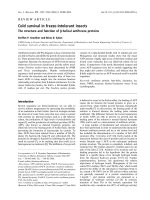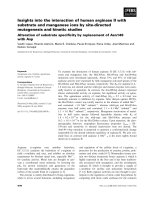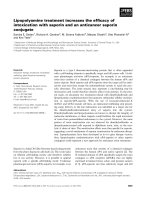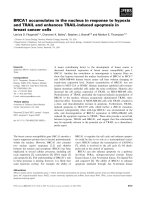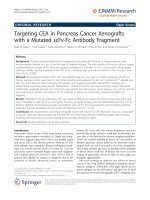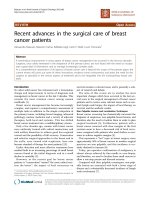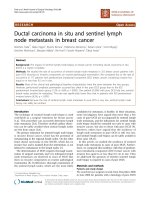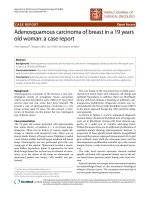Báo cáo khoa học: "Postmastectomy irradiation in breast in breast cancer patients with T1-2 and 1-3 positive axillary lymph nodes: Is there a role for radiation therapy" ppsx
Bạn đang xem bản rút gọn của tài liệu. Xem và tải ngay bản đầy đủ của tài liệu tại đây (314.96 KB, 8 trang )
RESEARCH Open Access
Postmastectomy irradiation in breast in breast
cancer patients with T1-2 and 1-3 positive
axillary lymph nodes: Is there a role for
radiation therapy?
Rusen Cosar
1*
, Cem Uzal
1
, Fusun Tokatli
2
, Bengu Denizli
1
, Mert Saynak
1
, Nesrin Turan
3
, Sernaz Uzunoglu
4
,
Alaattin Ozen
1
, Atakan Sezer
5
, Kamuran Ibis
1
, Burcu Uregen
1
, Vuslat Yurut-Caloglu
1
and Zafer Kocak
1
Abstract
Background: We aimed to evaluate retrospectively the correlation of loco-regional relapse (LRR) rate, distant
metastasis (DM) rate, disease free survival (DFS) and overall survival (OS) in a group of breast cancer (BC) patients
who are at intermediate risk for LRR (T1-2 tumor and 1-3 positive axillary nodes) treated with or without
postmastectomy radiotherapy (PMRT) following modified radical mastectomy (MRM).
Methods: Ninety patients, with T1-T2 tumor, and 1-3 positive nodes who had undergone MRM received adjuvant
systemic therapy with (n = 66) or without (n = 24) PMRT. Patient-related characteristics (age, menopausal status,
pathological stage/tumor size, tumor location, histology, estrogen/progesterone receptor status, histological grade,
nuclear grade, extracapsular extension, lymphatic, vascular and perineural invasion and ratio of involved nodes/
dissected nodes) and treatment-related factors (PMRT, chemotherapy and hormonal therapy) were evaluated in
terms of LRR and DM rate. The 5-year Kaplan-Meier DFS and OS rates were analysed.
Results: Differences between RT and no-RT groups were statistically significant for all comparisons in favor of RT
group except OS: LRR rate (3%vs 17%, p = 0.038), DM rate (12% vs 42%, p = 0.004), 5 year DFS (82.4% vs 52.4%,
p = 0.034), 5 year OS (90,2% vs 61,9%, p = 0.087). In multivariate analysis DM and lymphatic invasion were
independent poor prognostic factors for OS.
Conclusion: PMRT for T1-2, N1-3 positi ve BC patients has to be reconsidered according to the prognostic factors
and the decision has to be made individually with the consideration of long-term morbidity and with the patient
approval.
Introduction
Modified radical mastectomy (MRM) is an important
treatment for many breast cancer (BC) patients espe-
cially with diffuse local disease and generally it is
accepted safe for local control in treatment of patients
with T1-2 and 1-3 positive axillary lymph nodes.
Although, the role of adjuvant systemic treatments is
relatively clear because numerous randomized clinical
trials have established that adjuvant chemotherapy and/
or hormonal treatment prolongs the s urvival of patients
in this group. The role of post-mastectomy radiotherapy
(PMRT) is the most controversial issue for adjuvant
breast cancer management [1].
In subgroup analysis of Denmark 82b-c trials (DBG) it
is strongly indicated that the benefit of PMRT is equally
pronounced in patients with 1-3 positive nodes as in
patients with 4 and more positive nodes [2-4]. Decision
for making PMRT according to t he number of positive
lymph node status is c ontroversial due to discrepancies
in reported baseline LRR risks [5]. The National Cancer
InstituteofCanadaClinicalTrialsGroupMA25study
was designed to assign in patients with 1-3 positive
* Correspondence:
1
Trakya University Hospital, Department of Radiation Oncology, Edirne,
TURKEY
Full list of author information is available at the end of the article
Cosar et al. Radiation Oncology 2011, 6:28
/>© 2011 Cosar et al; licensee BioMed Central Ltd. Thi s is an Open Access article distributed under the terms of the Creative Commons
Attribution License (http://creati vecommons.org/licenses/by/2.0), which permits unrestricted use, distribution, and reproduction in
any medium, provided the original work is properly cited.
nodes to receive either loco-regional RT or no-RT after
MRM randomly. However, this study was closed
because of lack of accrual. Another closed study
(MA20), which was conduct ed by the same group,
included patients who had undergone breast-conservi ng
surg ery with high-risk node positive, and node negative,
were randomly allocated to receive standard only breast
RT versus locoregional RT. Nevertheless, this study
could not be an answer to our question because the
allocated patients had undergone breast conserving sur-
gery therefore, were subjected to receive planned breast
RT. The particular question, which requires a precise
answer by the radiation oncologists, is the rate of LRR
in these 1-3 lymph node positive patients who never
received RT following MRM. Additional two questions
are also important: would disease free survival (DFS),
even overall surviva l (OS) could be affected by PMRT.
Unfortunately, the answer will wait to be c larified by
randomized trials in coming years. Ongoing randomized
SUPREMO study was designed to evaluate the results of
chest wall irradiation in management of the pat ients
underwent MRM with pT1N0M0 or pT2N0-1M0 dis-
ease. It may give us better information the role of
PMRT in this patient group [6].
Radiation oncologists often confront patients with 1-3
positive lymph nodes following MRM in their routine
clinical practice and which factors should be considered
as prognostic risk factors when deciding whether a
patient should receive RT to chest wall with or without
peripheral lymphatics, is a hard to make decision. Based
on DBG report, we decided to eva luate our patients ret-
rospectively [2-4]. We aimed to evaluate the correlation
of loco-regional relapse (LRR) rate, distant metastasis
(DM) rate, DFS and OS in a group of BC patients at
intermediate risk for LRR (T1-2 and 1-3 positive axillar y
nodes) treated with or without RT following MRM.
Materials and methods
We evaluated 600 BC patients treated or had their fol-
low-up at our clinic from July 1999 to Dece mber 2006.
Ninety BC patients, who had undergone MRM and had
T1-T2 and 1-3 positive axill ary lymph nodes, all but one
of whom received adjuvant systemic therapy with (n =
66) or without (n = 24) PMRT were analysed. Fifteen of
90 patients were previously treated in another clinic
prior to July 1999 (first patient operated at Jan uary
1992) and had their follow-up at our clinic. All patients
underwent MRM with clear surgical margins (>1 mm).
Axillary lymph node staging was performed in all
patients. Pathological staging was reviewed based on
AJCC 2002. The date of evaluation was January 2009.
Patient-related characteristi cs (age, menopausal status,
pathological stage/tumor size, tumor location, histology,
estrogen/progesterone receptor status, histological grade,
nuclear grade, extracapsular extension, lymphatic, vascu-
lar and perineural invasion, and ratio of involved nodes/
dissected nodes), and treatment-related factors (PMRT,
chemotherapy and hormonal therapy) were analyzed
(Table 1).
Treatment
All patients underwent MRM. Median tumor size was 3
cm (range, 1-5). The median number of dissected lymph
nodes was 11 (range, 3-37). Following MRM, FAC
(5-fluorouracil, adriamycin, cyclophosphamide) or CMF
(cyclophosphamide, methotrexate, 5-fluorouracil) adju-
vant chemotherapy were administered to 89 of patients
(99%) and 66 patients (73%) received adjuvant endocrine
therapy for 5 years. One patient only received hormonal
therapy. Sixty-six patients (73%) received PMRT (RT
group) and 24 patients (27%) did not (no-RT group). All
patients were simulated with conventional simulator.
Thepostmastectomychestwallreceivedadoseof
50 Gy through two tangential fields with 6 MV foton.
The mid-axilla received a dose of 50 Gy through a n
anterior supraclavicula r and posterior axillary fields with
cobalt-60. Intended dose was given in 25 fractions in a
period of 5 week.
Follow-up
The patients were fol lowed with office visits and physi-
cal examinations every 3 mont hs for the first 3 years,
every 6 months for the fourth and fifth years, and
annually after 5 years. Che st X-ray and liver sonogra-
phy were requested every 6 months for the first 3
years and annually for the fourth and fifth years.
Whole body bone scans were requested annually
for the first 5 years. Median follow-up time was
72 months (range, 30-204 months).
Recurrence
Loco-regional recurrence was identified as local recur-
rence (chest wall alone) or peripheral lymphatic recur-
rence (axillary, supraclavicular and internal mammary
lymph nodes alone). Local recurrence was defined as
any relapse in the area of surgery between the s ternum
and the anterior axillary line, and below the inferior cla-
vicular fossa and above the seventh rib. Any relapse
involving the axillary lymph nodes, and/or other nodes
in the infra or supraclavicular fossa or in the internal
mammary chain was considered as a regional recur-
rence. Any recurrence outside these areas was defined
as DM.
Statistical Analysis
LRR and DM rates were calculated by first event analy-
sis. If a distant metastasis developed, then subsequent
local failures were censored (vice versa). 5 years actuarial
Cosar et al. Radiation Oncology 2011, 6:28
/>Page 2 of 8
(Kaplain-Meier) DFS and OS rates were computed. When
calculating DFS, any failure (local or distant) and/or death
from any cause were considered as an event. Statistical sig-
nificance of outcome differences was determined using the
log-rank test. Multivariate analyses of prognostic variables
for each outcome were performed using Cox proportional
hazards modeling with and without the percentage of posi-
tive lymph nodes as a covariate. All statistical tests were 2-
tailed, with the level of significance established at p ≤ 0.05.
All analyses were conducted using SPSS software (version
16.0.1; S PSS Inc., Chicago, IL).
Results
The patient characteristics are shown in Table 1. Med-
ian lymph node examined in our series was 12 for RT
group and 10 for no-RT group. It appears that the two
groups were evenly distribu ted regarding age, menopau-
sal status, dissected lymph nodes, extracapsular exten-
sion, histology, high histological grade, hormonal
receptor status and systemic treatment. In the contrary
involved lymph nodes ratio, greater than 25% was higher
for RT group (20% vs 8%). Stage II B (T2N1) patients
constituted 80% of the RT group but 62.5% of the
no-RT group. The percentages of lymphatic, vascular
and perineural invasion, and high nuclear grade, which
are known t o be poor prognostic factors, were higher in
RT group but not statistically signif icant. Surgical mar-
gins were negative for all patients. Tumor location dis-
tribution was also different between the groups, medial
location being slightly higher in RT group (30% vs 25%).
For the entire group, LRR and DM rates were 7% and
20%, respectively, and 5 years actuarial DFS and OS
rates were 73.6% and 81.9%, respectively.
Differences between RT and no-RT groups were sta-
tistically significant for allcomparisonsinfavorofRT
group except OS: LRR rate (3%vs 17%, p = 0.038), DM
rate (12% vs 42%, p = 0.004), 5 year DFS (82.4% vs
52.4%, p = 0.034, 42.842-132.158 CI 95%), and 5 year
OS (90.2% vs 61,9%, p = 0.087, 71.127-199.340 CI95%)
(Figure 1, 2, 3) (Table 2).
There was no LRR at chest wall and peripheral lympha-
tics simultaneously nor metachronously. For the entire
group, all LRRs occurred as the first event, without DM.
Four patients in no-RT group had LRR. All of 8 DM in
RTgroupoccurredasthefirsteventwithoutLRR,but
only 10 of 14 DM (71%) in no-RT group were the first
event, 4 of whom presented with or followed LRR.
Clinical characteristics of patients with LRR are shown
in Table 3. LRRs’ histologic types were invasive ductal
carcinoma for 4 patients and invasive lobular carcinoma
Table 1 Clinical characteristics of patients undergoing
modified radical mastectomy
Groups Radiotherapy
n=66
No-
Radiotherapy
n=24
Characteristic n (%) n (%)
Age, years
Median 51 48 50 50
Range 28-73 34-77
≤50 32 12
Postmenopausal status 37 56 13 54
Lymph nodes examined
Median 12 10
Range (3-37) (4-31)
Involved/dissected lymph nodes
Median 13 15 2 14
Range (4-38) (6-25)
≥ 25% 20 8
Extracapsular extension 26 39 10 42
Stage (Tumor size)
IIA (T1N1) 13 20 9 37.5
IIB (T2N1) 53 80 15 62.5
Tumor location
Medial 20 30 6 25
Central 16 24 6 25
Lateral 30 46 12 50
Histology
Ductal 53 80 18 75
Lobuler 3528
Other (mixt, mucinous,
medullary)
10 15 4 17
Histological Grade
I 10 15 8 33
II 39 59 11 41
III 17 26 5 26
Nuclear Grade
I 14 22 8 33
II 26 39 11 46
III 26 39 5 21
Invasion
Lymphatic 47 71 11 46
Vascular 42 64 13 54
Perineural 34 52 5 21
Receptors
Estrogen receptor 49 74 17 71
Progesteron receptor 51 77 17 71
Systemic therapies
Hormonotherapy 49 74 17 71
Chemotherapy 66 100 23 96
Cosar et al. Radiation Oncology 2011, 6:28
/>Page 3 of 8
for 1 patient and invasive Paget’s disease for 1 patient.
Remarkably, 3 of the patients with LRR (50%) were
younger than 50 of age and premenopousal in no-RT
group. Interestingly any patient with LRR had no extra-
nodal extension in our series. As for DM, lymphatic inva-
sion had an impact on LRRs existing in 5 out of 6 (83%).
All LRRs in RT group wer e T2 tumors (3 cm and 4 cm)
but only 1 of 4 LRRs in no-RT group was T2 (4.5 cm).
Regarding the ratio of involved nodes, 13 patients in RT
group (20%) had a ratio equal to or higher than 25% (high-
est ratio 37%). Eleven of them (85%) were alive without an
event but 2 had recurrences; 1 with LRR and DM simulta-
neously,theotheronewithonlyDMbothdyingsubse-
quently after treatment. Two patients in no-RT group
(8%) had a ratio equal to 25%. One of them developed
LRR first followed by DM, the other one had DM without
LRR, both dying subsequently after treatment.
There was distant metastatic event in 10 patients in
no-RT group (42%) . Five of them developed bone
metastasis first and liver metastasis subsequently. Two
Local Failure-Free Survival
Radiotherapy
t
e (%)
No Radiotherapy
r
vival Ra
t
e
-Free Su
r
a
l Failur
e
Long –rank p value=0.038
(78.152-220.361 CI 95%)
Loc
a
Figure 1 Kaplan-Meier curve of local failure-free probability
(Five year local-regional failure-free survival in RT group
92.6%, no-RT group 87.1%, p = 0.038, (78.152-220.361 CI
95%)).
Disease-Free Survival
%
)
Radiotherapy
a
l Rate (
%
e
e Surviv
a
No Radiotherapy
L
k l 0 034
i
sease-Fr
e
L
ong
–
ran
k
p va
l
ue=
0
.
034
(42.842-132.158 CI 95%)
D
i
Figure 2 Kaplan-Meier curve of disease-free probability.(Five
years DFS in RT group 82.4%, no-RT group 52.4%, p = 0.034 (42.842-
132.158 CI 95%)).
Overall Survival
Radiotherapy
No Radiotherapy
Long-rank P value =0.087
(71.127-199.340 CI 95%)
Figure 3 Kaplan-Meier curve of overall survival probability
(Five years OS in RT group 90.2%, no-RT group 61.9%, p =
0.087 (71.127-199.340 CI 95%)).
Table 2 The distribution of recurrences and survivals in
radiotherapy and no-radiotherapy group
Group Radiotherapy
n=66
No-
Radiotherapy
n=24
P
n% n %
Local-regional recurrence
Chest wall alone 1 1.5 2 8
Peripheral lymphatics alone 1 1.5 2 8
Total LRR
a
2 3.0 4 17 0.038
Distant metastasis 81210420.004
Total Events 10 15 14 58 0.009
Current Status
Death 6 9.0 10 42 0.002
DFS
b
(5 yrs actuarial) 82.4 52.4 0.034
OS
c
(5 yrs actuarial) 90.2 61.9 0.087
a
Local-regional recurrence,
b
Disease-free survival,
c
Overall survival.
Cosar et al. Radiation Oncology 2011, 6:28
/>Page 4 of 8
patients had lung metastasis and two had liver metasta-
sis. One patient had mediastinal involvement. On the
other hand, 8 patients had DM in RT group (16%). Five
of eight patients had bone metastasis only, two had both
bone and liver metastases and one had lung metastasis
only. Tumor location had also an impact in RT group
for DM (e ight patients, four of them having their pri-
mary tumor location medially and centrally). Most
remarkab le event of all is that in all patients developing
DM but one (in no-RT group) had lymphatic invasion
at their primary tumors.
In univaried analysis, lymphatic invasion (p = 0.032),
perineural invasion (p = 0.046), pathological stage
(tumor size) (p = 0.024), PMRT (p = 0.032), LRR (p =
0.047), DM (p = 0.000), and total event (p = 0.002) were
prognostic factors which affected DFS. Hormonotherap y
could not reach the significance (p = 0.056) for DFS. In
multivariate analysis, only DM was independent poor
prognostic factor for DFS (p = 0.000).
In univaried analysis, lymphatic invasion (p = 0.022),
ratio of positive lymph node (p =0.001),PMRT(p =
0.087), DM (p = 0.000), and total event ( p = 0.008) were
prognostic factors which affected OS. Neither hormo-
notherapy nor pathological stage could not reach the
significance (p = 0.051 and p = 0.065 respectively) for
OS. In multivariate analysis, DM (p = 0.000) and lym-
phatic invasion (p = 0.021) were independent poor prog-
nostic factors for OS. The predictive factors for OS in
univariate time- dependent analysis and the independent
predictive factors for OS defined by Cox’sproportional
hazards model are showed in Table 4.
None of the patients in the entire group developed
brachial plexopathy, any sy mptomatic pneumoni tis and/
or severe lymph edema, neit her any had secondary can-
cer in the follow-up period.
Discussion
Our retrospective study consists of relatively small num-
ber of patients and PMRT decision recommended
according to the poor prognostic factors of the patient
at the discrepancy of the radiation oncologist. Our
results showed that PMRT in T1-2 and 1-3 axillary
lymph node positive patients caused a statistically signif-
icant improvement in the DFS (p = 0.034), in spite of
higher risk status in RT group in terms of pathological
stage/tumor size, involved lymp h node ratio ≥ 25%, high
nuclear grade, lymphatic, vascular and perineural inva-
sion. The improvement of OS in RT grou p was not sta-
tistically significant (p = 0.087).
Actually, LRR rates at the long term after MRM may be
higher than estimated rates. In our series, LRR rate in no-
RT group was higher significantly compared with RT
group (17% vs 3%). The trial by Ragaz et al. reports a 5-
year LRR rate of 21% among women who did not
undergo RT and 10% among those who received RT; 10-
year rates were 25% and 1 3%, respectively [7]. Similarly,
Overgaard et al. reports a 114-month rate of LRR alone
of 26% for women given chemotherapy without RT and
5% for those given both chemotherapy and RT [3].
During recent decades, as a local treatment RT has
been considered to contribute only to local-regional dis-
ease control in breast cancer patients. Indeed, data from
Table 3 Clinical characteristics of patients with LRR
Group RT No-RT
Patient Patient 1 Patient 2 Patient 1 Patient 2 Patient 3 Patient 4
Age 63 77 43 40 49 55
Menopouse Post Post Pre Post Pre Post
Primary tumor size (cm) 3 4 2 1.5 2 4.5
Primary tumor location Lat
a
Lat Lat Med
b
Med Lat
Histology IDC
c
IDC ILC IDC IPD
d
IDC
Nuclear Grade II I II III II II
Histologic Grade IIIIIIIIII
Receptor - +++ - -
Lymphatic invasion +++++ -
Perineural invasion +-++- -
Extracapsular extension
Ratio of lymph node (%) 11 25 10 25 10 20
Hormonotherapy - +++ - -
Chemotherapy ++++++
Out-come No DM
e
Alive
DM
Death
DM
Death
DM
Death
DM
Death
DM
Alive
a
Lateral,
b
Medial,
c
Invasive ductal carcinoma,
d
Invasive Paget’s disease,
e
Distance metastasis.
Cosar et al. Radiation Oncology 2011, 6:28
/>Page 5 of 8
patients with T1-2 and 1-3 positive nodes suppor ts the
contention that PMRT improve not only locoregional
control, but also OS [4]. Results of our statistical analysis
proved that DM development is an independent prognos-
tic factor for OS. Distant metastasis rate was higher in
no-RT group compared to RT group (42% vs 12%), bone
and liver metastasis being higher in number as of distri-
bution among metastatic sites. Therefore, the higher LRR
rates in no-RT group should be attributed to the fact that
locoregional treatment with RT improves survival by
reducing LRR which is not prevent significantly by adju-
vant chemotherapy and/or hormonotherapy alone [7-10].
All patients in the RT group received systemic adjuvant
therapy.
It was state by Truong et al., that the percentage of
positive lymph nodes should be consider in adjuvant
therapy decisions for women with 1-3 axillary positive
lymph nodes who undergo MRM [11]. The prese nce of
25% or more lymph nodes that are positive identified
patients at higher risk of LRR and DM who may benefit
from adjuvant RT and more aggressive systemic treat-
ment regimens [11-15]. The median lymph node invol-
vement ratio in our RT and no-RT groups is 15% and
14%, respectively. A great majo rity of pati ents in no-RT
Table 4 The impact of clinical and pathologic factors on the overall survival
Factors Assessed Univariate Analysis Multivariate Analysis
Hazard Ratio 95% CI
a
p
b
Hazard Ratio 95% CI p
c
Age
≤50 (vs >50) 0.947 0.32-2.80 0.922
Menauposal status
No (vs yes) 0.966 0.33-2.87 0.951
Histologic grade
3 (vs, 1-2) 1.108 0.36-3.39 1.000
Nuclear grade
3 (vs 1-2) 1.037 0.30-3.62 0.859
Lymphatic invasion
Yes (vs absent) 3.955 0.78-11.3 0.022 3.052 0.98-9.87 0.021
Vascular invasion
Yes (vs absent) 1.631 0.46-5.82 0.547
Perineural invasion
Yes (vs absent) 1.771 0.56-5.60 0.409
Tumor size
2.1-5 cm (vs ≤2 cm) 3.323 1.34-12.1 0.013 1.865 1.21-11.8 1.124
Estrogen receptor
Negative (vs positive) 1.717 0.44-6.65 0.115
Progesteron receptor
Negative (vs positive) 2.120 0.68-15.35 0.102
Ratio of positive lymph node
≥25% (vs <25%) 3.471 1.14-10.57 0.001 2.139 1.28-11.21 1.239
Hormonothreapy
No (vs yes) 2.819 0.91-8.75 0.110
Postoperative radiotherapy
No (vs yes) 2.143 1.22-17.95 0.087 1.253 1.18-16.13 1.124
Event
Yes (vs absent) 4.743 1.70-7.28 0.008 2.511 1.74-6.93 0.0812
Local failure
Yes (vs absent) 3.462 0.99-30.08 0.067 1.242 1.12-23.7 1.318
Distant metastasis
Yes (vs absent) 3.667 1.85-7.26 0.00 5.437 1.92-8.13 0.000
a
Confidence interval,
b
Kaplan-Meier analysis (log-rank test),
c
Cox regression analysis.
Cosar et al. Radiation Oncology 2011, 6:28
/>Page 6 of 8
group had involved lymph nodes of less than 25%, only
2patients(8%)inthisgrouphadthisratioequalto
25%. Despite the situation, their LRR, total event, death
rates, and DFS rates were significantly worse than RT
group in which 13 patients (20%) had this disadvantage.
Another debate about PMRT is about the rational of
peripheral lymphatic por tal addition to the chest wall
irradiation. In our series there were 3 peripheral lym-
phatic recurrence out of 6 LRR in the entire group, all
situated in supraclavicular region suggesting that a small
supraclavicular field (excluding humeral head) addition
to the chest wall portal would be adequate, which also
would prevent a subsequent arm lymphedema.
The question whether with current standards of sur-
gery and systemic adjuvant chemotherapy in this parti-
cular subset of intermediate risk patients (N1- 3 positive
and pT2) with additional risk factors, the prevention of
local recurrences through only chest wall irradiation will
improve survival, is investigated in an ongoing study of
MRC/EORTC SUPREMO trial [6,16].
Arriagada reported a retrospective analysis of IGR
database between 1963-1983 on 1105 patients treated by
total mastectomy and axillary dissection who did not
receive adjuvant chemotherapy or hormonotherapy. The
result showed an advantage in favor of PMRT in N1-3
positive patients [17]. In a more recent study Cheng et
al reported that in addition to axillary nodal status,
estrogen receptor status, lymphovascular space invasion
and age at diagnosis were all found to be significant to
predict LRR and the impact of PMRT on survival [18].
Beside these individual studies number of reviews and
metaanalyses demonstrate an absolute survival benefit of
approximately 5% to 10% and approximately 66% to
75% relative reduction in LRR, with PMRT [19-23].
A typical explanation expressed in the following cita-
tion from the NIH Consensus Report 2000 [5]: “There
is evidence that women with high risk of LRR after
MRM benefit from PMRT. This high-risk group
includes women with four or more positive nodes or an
advanced primary tumor. At this time, the role of
PMRT for women with 1 to 3 positive lymph nodes
remains uncertain and is being examined in a rando-
mized clinical trial”. Many surgeons and radiation oncol-
ogist are not recommending PMRT to 1-3 axillary
lymph node positive patients with a common under-
standing that RT will cause to ipsilateral lymphedema of
the upper extremity. However, retrospective evaluation
of series in the English literature in conjunction with
Overgaard et al.’ s article opens a new window in the
management of 1-3 axillary lymph node positive
patients. The authors clearly indicated that PMRT sig-
nificantly and subs tantially improved loco-regional con-
trol and OS in all node-positive patients. Hence,
improvement is as pronounced in patients with 1-3
positivenodesasinpatientswith4ormorepositive
nodes, and nearly the same number of patients is
needed to treat to avoid a loco-regional recurrence and/
or death in both groups. Therefore, in management of
patients with 1-3 axillary lymph nodes positive patients
should be reconside red thoroughly with the guidance of
long-term results of studies like DBG 82 and British
Columbia randomized trial [2,15].
When making decision for PMRT, radiation oncolo-
gist needs additional parameters for this group of
patients. As Overgaard et al. mentioned in their article,
it is obvious that the number of positive lymph nodes
solely is an extremely crude way of defining a potential
indication for PMRT. More information may come
from other clinicopathologic parameters (e.g., capsule
and lymphovascular invasion, malignancy grading,
etc.). Moreover, recent years have given increasing
knowledge about the prognostic value of new molecu-
lar and genetic markers in order to select patients for
adjuvant systemic therapy [24-26]. In coming years,
these new markers might also be proven as predictors
for selecting tumors which are more sensitive to RT
than the others.
Conclusion
Our results share some similar and consistent findings
with the recent literature as presented above, in which
PMRT resulted to improve local-regional control, DFS
and OS. Selection of patients for PMRT in this inter-
mediate risk group is a challenging situation, because
some of them have one or more predictor and prognos-
tic factors for failure. It appears that the benefit of RT is
worth of the risk of treatment morbidity with accurate
selection.
PMRT for T1-2 and N1-3 positive patients has to be
reconsidered according to the prognostic factors and the
decision has to be made individually with the considera-
tion of long-term mo rbidity and with the patient
approval, until further data are available.
Author details
1
Trakya University Hospital, Department of Radiation Oncology, Edirne,
TURKEY.
2
Medicana Hospital, Department of Radiation Oncology, Istanbul,
TURKEY.
3
Trakya University Hospital, Department of Biostatistics, Edirne,
TURKEY.
4
Trakya University Hospital, Department of Internal Medicine,
Division of Medical Oncology, Edirne, TURKEY.
5
Trakya University Hospital,
Department of Surgery, Edirne, TURKEY.
Authors’ contributions
RC coordinated the entire study. Clinical data collection was done by BD,
AO, BU, and KI. Data analysis was done by RC, CU, NT and MS.
The manuscript was prepared by RC and AO. Corrections and/or
improvements were suggested by CU, BD, MS, AO, SU, AS, VYC and ZK.
Major revisions were done by RC, CU, MS and AO. All authors read and
approved the final manuscript.
Competing interests
The authors declare that they have no competing interests.
Cosar et al. Radiation Oncology 2011, 6:28
/>Page 7 of 8
Received: 27 October 2010 Accepted: 30 March 2011
Published: 30 March 2011
References
1. Early Breast Cancer Trialists’ Collaborative Group (EBCTCG): Effects of
chemotherapy and hormonal therapy for early breast cancer on
recurrence and 15-year survival: an overview of the randomised trials.
Lancet 2005, 365(9472):1687-717.
2. Overgaard M, Nielsen HM, Overgaard J: Is the benefit of postmastectomy
irradiation limited to patients with four or more positive nodes, as
recommended in international consensus reports? A subgroup analysis
of the DBCG 82 b&c randomized trials. Radiother Oncol 2007, 84:102-103.
3. Overgaard M, Hansen PS, Overgaard J, et al: Postoperative radiotherapy in
high-risk premenopausal women with breast cancer who receive
adjuvant chemotherapy. Danish Breast Cancer Cooperative Group 82b
Trial. N Engl J Med 1997, 337:949-955.
4. Overgaard M, Christensen JJ, Johansen H, et al: Evaluation of radiotherapy
in high-risk breast cancer patients: report from the Danish Breast Cancer
Cooperative Group (DBCG 82) Trial. Int J Radiat Oncol Biol Phys 1990,
19:1121-1124.
5. Eifel P, Axelson JA, Costa J, et al: National Institutes of Health Consensus
Development Conference Statement: adjuvant therapy for breast cancer,
November 1-3, 2000. J Natl Cancer Inst 2001, 93:979-989.
6. Kunkler IH, Canney P, van TG, et al: Elucidating the role of chest wall
irradiation in intermediate risk breast cancer: The MRC/EORTC SUPREMO
trial. Clin Oncol (R Coll Radiol) 2008, 20:31-34.
7. Ragaz J, Olivotto IA, Spinelli JJ, et al: Locoregional radiation therapy in
patients with high-risk breast cancer receiving adjuvant chemotherapy:
20-year results of the British Columbia randomized trial. J Natl Cancer
Inst 2005, 97:116-126.
8. Harris JR, Halpin-Murphy P, McNeese M, Mendenhall NP, Morrow M,
Robert NJ: Consensus Statement on postmastectomy radiation therapy.
Int J Radiat Oncol Biol Phys 1999, 44:989-990.
9. Recht A, Edge SB, Solin LJ, et al: American Society of Clinical Oncology.
Postmastectomy radiotherapy: clinical practice guidelines of the
American Society of Clinical Oncology. J Clin Oncol 2001, 19:1539-1569.
10. Recht A, Bartelink H, Fourquet A, et al: Postmastectomy radiotherapy:
questions for the twenty-first century. J Clin Oncol 1998, 16:886-2889.
11. Truong PT, Berthlet E, Lee J et al: The prognostic significance of the
percentage of positive/dissected axillary lymph nodes in breast cancer
recurrence and survival in patients with one to three positive axillary
lymph nodes. Cancer 2005, 103:2006-2014.
12. Voordeckers M, Vinh-Hung V, Van de Steene J, Lamote J, Storme G: The
lymph node ratio as prognostic factor in node-positive breast cancer.
Radiother Oncol 2004,
70:225-230.
13. Van der Wal BCH, Butzelaar RMJM, van der Meij S, Boermeester MA: Axillary
lymph node ratio and total number of removed lymph nodes:
predictors of survival in Stage I and II breast cancer. Eur J Surg Oncol
2002, 28:481-489.
14. Megale Costa LJ, Soares HP, Gaspar HA, et al: Ratio between positive
lymph nodes and total dissected axillary lymph nodes as an
independent prognostic factor for disease-free survival in patients with
breast cancer. Am J Clin Oncol 2004, 27:304-306.
15. Truong PT, Olivotto IA, Kader HA, et al: Selecting breast cancer patients
with T1-T2 tumors and one to three positive axillary nodes at high
postmastectomy locoregional risk for adjuvant radiotherapy. Int J Radiat
Oncol Biol Phys 2005, 61:1337-1347.
16. Russell NS, Kunkler IH, Tienhoven G, Canney PA, Thomas J, Bartlett J, et al:
Postmastectomy Radiotherapy: Will the Selective Use of
Postmastectomy Radiotherapy Study End the Debate? J Clin Oncol 2009,
27(6):996-997.
17. Arriagada R, Lê MG: Number of positive axillary lymph nodes and post-
mastectomy radiotherapy effectin breast cancer patients. Radiother Oncol
2007, 84(1):102-103.
18. Cheng SH, Horng CF, West M, et al: Genomic prediction of locoregional
recurrence after mastectomy in breast cancer. J Clin Oncol 2006,
24:4594-602.
19. Val Gebski, Marivic Lagleva, Anthony Keech, John Simes, Langlands OAllan:
Survival Effects of Postmastectomy Adjuvant Radiation Therapy Using
Biologically Equivalent Doses: A Clinical Perspective. J Natl Cancer Inst
2006, 98(1):26-38.
20. Giardona SH, Kuo YF, Freeman JL, et al: Risk of cardiac death after
adjuvant radiotherapy for breast cancer. J Natl Cancer Inst 2005,
97:419-424.
21. Rutqvist LE, Rose C, Cavallin-Stahl E: A systematic overview of radiation
therapy effects in breast cancer. Acta Oncol 2003, 42:532-545.
22. Van de Steene J, Soete G, Storme G: Adjuvant radiotherapy for breast
cancer significantly improves overall survival: The missing link. Radiother
Oncol 2000, 55:263-272.
23. Whelan TJ, Julian J, Wright J, et al: Does locoregional radiation therapy
improve survival in breast cancer? A meta-analysis. J Clin Oncol 2000,
18:1220-1229.
24. Sotiriou C, Wirapati P, Loi S, et al: Gene expression profiling in breast
cancer: understanding the molecular basis of histologic grade to
improve prognosis. J Natl Cancer Inst 2006, 98:262-272.
25. Kreike B, Halfwerk H, Kristel P, et al: Gene expression profiles of primary
breast carcinomas from patients at high risk for local recurrence after
breast-conserving therapy. Clin Cancer Res 2006, 12:5705-5712.
26. Fisher B, Wolmark N, Redmond C, et al: Findings from NSABP Protocol No.
B-04: comparison of radical mastectomy with alternative treatments. II.
The clinical and biologic significance of medial-central breast cancers.
Cancer 1981, 48:1863-1872.
doi:10.1186/1748-717X-6-28
Cite this article as: Cosar et al.: Postmastectomy irradiation in breast in
breast cancer patients with T1-2 and 1-3 positive axillary lymph nodes:
Is there a role for radiation therapy? Radiation Oncology 2011 6:28.
Submit your next manuscript to BioMed Central
and take full advantage of:
• Convenient online submission
• Thorough peer review
• No space constraints or color figure charges
• Immediate publication on acceptance
• Inclusion in PubMed, CAS, Scopus and Google Scholar
• Research which is freely available for redistribution
Submit your manuscript at
www.biomedcentral.com/submit
Cosar et al. Radiation Oncology 2011, 6:28
/>Page 8 of 8
